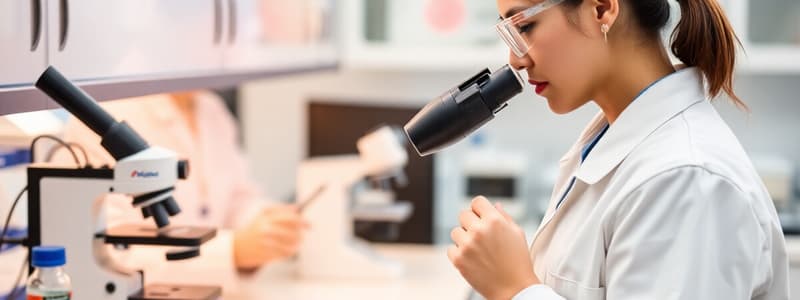Podcast
Questions and Answers
What does Turnaround Time (TAT) primarily assess in a laboratory setting?
What does Turnaround Time (TAT) primarily assess in a laboratory setting?
- The percentage of samples that pass quality control
- The accuracy of test results
- The repeatability of test results
- The length of time from sample collection to result reporting (correct)
Which metric is used to evaluate how close test results are to the true value?
Which metric is used to evaluate how close test results are to the true value?
- Error Rates
- Test Precision
- Test Accuracy (correct)
- Sample Rejection Rate
Which of the following performance metrics focuses on the repeatability of test results?
Which of the following performance metrics focuses on the repeatability of test results?
- Test Accuracy
- Compliance with Standards
- Test Precision (correct)
- Turnaround Time
What is the purpose of benchmarking in laboratory performance metrics?
What is the purpose of benchmarking in laboratory performance metrics?
Which metric tracks errors occurring before, during, and after analytical processes?
Which metric tracks errors occurring before, during, and after analytical processes?
Which performance metric primarily indicates laboratory efficiency and workflow effectiveness?
Which performance metric primarily indicates laboratory efficiency and workflow effectiveness?
What does the term 'quality control metrics' refer to in a laboratory performance context?
What does the term 'quality control metrics' refer to in a laboratory performance context?
In terms of performance metrics, which of the following accurately represents sensitivity?
In terms of performance metrics, which of the following accurately represents sensitivity?
Which performance metric assesses how well a laboratory adheres to established guidelines?
Which performance metric assesses how well a laboratory adheres to established guidelines?
Which of the following best describes test precision?
Which of the following best describes test precision?
Which performance metric includes the frequency of pre-analytical, analytical, and post-analytical errors?
Which performance metric includes the frequency of pre-analytical, analytical, and post-analytical errors?
What is the primary benefit of using performance metrics in a laboratory setting?
What is the primary benefit of using performance metrics in a laboratory setting?
Which factor is essential for the successful implementation of performance metrics in a laboratory?
Which factor is essential for the successful implementation of performance metrics in a laboratory?
Flashcards are hidden until you start studying
Study Notes
Laboratory Quality Indicators: Performance Metrics
-
Definition: Performance metrics are quantifiable measures used to assess the efficiency, accuracy, and overall quality of laboratory processes and results.
-
Types of Performance Metrics:
- Turnaround Time (TAT):
- Measures the time taken from sample receipt to result reporting.
- Essential for evaluating efficiency.
- Test Accuracy:
- Indicates how close test results are to the true value.
- Assessed through metrics like sensitivity and specificity.
- Test Precision:
- Reflects the repeatability of test results across multiple runs.
- Evaluated using standard deviation or coefficient of variation.
- Error Rates:
- Tracks pre-analytical, analytical, and post-analytical errors.
- Helps identify areas for improvement.
- Turnaround Time (TAT):
-
Key Performance Indicators (KPIs):
- Sample Rejection Rate:
- Percentage of samples that are rejected due to quality issues.
- Quality Control (QC) Pass Rate:
- Percentage of QC samples that pass within acceptable limits.
- Compliance with Standards:
- Adherence to regulatory and accreditation standards (e.g., ISO, CLIA).
- Sample Rejection Rate:
-
Benchmarking:
- Comparison of performance metrics against industry standards or peer laboratories.
- Helps to identify best practices and areas needing improvement.
-
Continuous Improvement:
- Utilization of performance metrics to implement quality improvement initiatives.
- Regular reviews of metrics to drive operational changes.
-
Data Management:
- Importance of accurate data collection and reporting for performance metrics.
- Use of laboratory information systems (LIS) for tracking and analysis.
-
Reporting and Communication:
- Regularly updating stakeholders on performance metrics.
- Use of dashboards and reports to visualize performance data for better decision-making.
Performance Metrics in Laboratories
- Performance Metrics: Quantifiable measures assessing laboratory efficiency, accuracy, and quality of processes/results.
Types of Performance Metrics
-
Turnaround Time (TAT):
- Time elapsed from sample receipt to result reporting, essential for evaluating lab efficiency.
-
Test Accuracy:
- Measures closeness of test results to true values, assessed via metrics like sensitivity (true positive rate) and specificity (true negative rate).
-
Test Precision:
- Indicates repeatability of test results across multiple tests, evaluated using standard deviation and coefficient of variation (CV).
-
Error Rates:
- Monitors pre-analytical, analytical, and post-analytical errors, aiding in identifying areas for quality improvement.
Key Performance Indicators (KPIs)
-
Sample Rejection Rate:
- Percentage of rejected samples due to quality issues, indicating overall sample quality.
-
Quality Control (QC) Pass Rate:
- Ratio of QC samples passing acceptable limits, reflecting accuracy and reliability of test methods.
-
Compliance with Standards:
- Adherence to regulatory and accreditation standards (e.g., ISO, CLIA) ensuring quality and reliability in laboratory operations.
Benchmarking
- Comparison of performance metrics against industry standards or peer laboratories, identifying best practices and areas needing improvement.
Continuous Improvement
- Utilization of performance metrics to implement quality improvement initiatives, facilitating regular reviews for operational changes.
Data Management
- Critical nature of accurate data collection and reporting for effective performance metrics; laboratory information systems (LIS) play a fundamental role in tracking and analysis.
Reporting and Communication
- Importance of regularly updating stakeholders on performance metrics using dashboards and reports to visualize data, supporting informed decision-making.
Laboratory Quality Indicators: Performance Metrics
- Performance metrics measure the efficiency, accuracy, and reliability of laboratory processes through quantitative data.
- Turnaround Time (TAT):
- Measures the duration from sample collection to the reporting of results.
- Serves as an indicator of laboratory workflow effectiveness.
- Test Accuracy:
- Represents the proportion of correct test results.
- Evaluated by comparing laboratory results with established gold standard methods.
- Test Precision:
- Reflects the consistency of test results across multiple trials.
- Assessed using statistical tools like standard deviation and coefficient of variation.
- Sensitivity and Specificity:
- Sensitivity: Measures the ability to correctly identify individuals with a condition (true positives).
- Specificity: Assesses the laboratory's accuracy in identifying individuals without the condition (true negatives).
- Quality Control (QC) Metrics:
- Tracks the frequency of quality control testing and the outcomes of those tests.
- Includes the rate of QC failures compared to acceptable limits.
- Error Rates:
- Monitors the occurrence of errors during pre-analytical, analytical, and post-analytical phases.
- Types of errors include sample mislabeling, reagent issues, and data entry mistakes.
- Compliance Rates:
- Evaluates adherence to regulatory standards and established internal protocols.
- Serves to ensure that laboratories are following necessary guidelines.
- Customer Satisfaction:
- Gathers feedback from healthcare providers and patients regarding laboratory services.
- Can be assessed through surveys or direct feedback collection methods.
- Performance metrics are essential for:
- Continuous quality improvement and evaluating laboratory performance.
- Meeting accreditation requirements and regulatory compliance.
- Enhancing patient safety by providing reliable test results.
- Optimizing laboratory efficiency and resource management.
- Implementation Considerations:
- Create clear definitions and benchmarks for each performance metric.
- Periodically review and refine metrics in alignment with laboratory goals and advancements in technology.
- Utilize data analytics tools for effective monitoring and reporting of performance metrics.
Studying That Suits You
Use AI to generate personalized quizzes and flashcards to suit your learning preferences.




